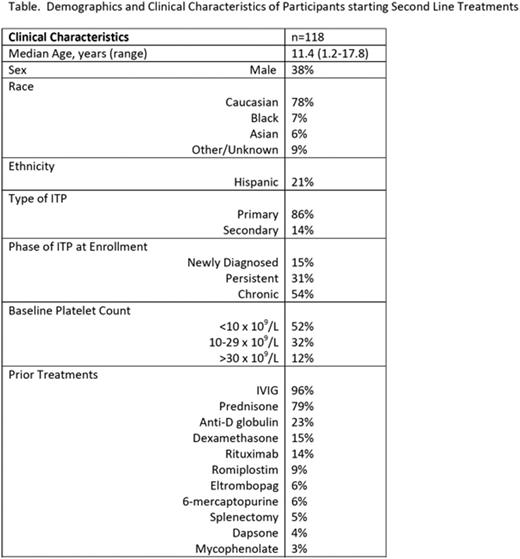Abstract
Background: Children with ITP who are prescribedsecond line treatments vary in terms of their clinical phenotype, prior treatments, and health related quality of life (HRQoL).
Objective: To describe the clinical characteristics and HRQoL of North American pediatric patients with ITP initiating second line treatments.
Methods: A longitudinal observational cohort of 118 children with ITP starting second line treatments was enrolled from 2013-2015 at 21 ICON centers. Enrollment requirements included age 1-17y and starting a second line treatment (not IVIG, steroids or anti-D) as monotherapy. Baseline demographic and clinical characteristics were recorded, including response to prior treatments, worst bleeding scores, and baseline platelet counts. Fisher's exact test was used to compare treatment with phase of ITP, age cohort, and gender. HRQoL was measured by patient/caregiver report using the Kids ITP Tool (KIT) where 0 is worst and 100 is best, while physicians assessed the perceived effect of ITP on patient HRQoL using a 5-point scale. Spearman correlations were used to test for association between bleeding, HRQoL, and duration of ITP. ANOVA was used to compare the mean KIT scores of the treatment groups.
Results: The clinical characteristics of the cohort are shown in the Table. Median age at enrollment was 11.4 y and 15% had newly diagnosed ITP, 31% had persistent ITP, and 54% had chronic ITP. The median number of prior treatments was 3 (range: 1-9). The prior response rate (platelet >30 x 109/µL and no bleeding) to prednisone was 59% and IVIG 66%. Fifty-five (47%) patients had received at least one prior second line treatment.
At enrollment, physicians reported that ITP had impacted the patients' HRQoL severely in 15%, significantly in 44%, moderately in 38%, and almost not at all in 3%. The mean score of the child KIT report was 71.4 (SD 17.2), the parent proxy KIT was 64.7 (SD 16.4), and the parent impact KIT was 36.1 (SD 19.2). The physician's assessment of the patient's HRQoL significantly correlated with the child report (p<.001) and parent proxy report (p<.001). The number of prior treatments and the worst bleeding score did not significantly correlate with the child or parent proxy KIT scores with the exception of gynecologic bleeding on the parent proxy report (p=.002). The duration of ITP significantly correlated with child (p=0.001) and parent proxy KIT scores (p=0.005) where a longer duration was associated with better HRQoL. The number of prior treatments, worst bleeding, and phase of ITP did not correlate with the parent impact KIT score.
Treatments selected for second line treatment included: rituximab (n=42), romiplostim (n=31), eltrombopag (n=20), oral immunosuppressants (n=16), splenectomy (n=4), and dapsone (n=3). The selected treatment was not significantly different by age, gender, baseline child KIT score, or duration of ITP. Baseline parent proxy KIT scores varied significantly between selected treatments (p=0.03) and were significantly lower in children starting on eltrombopag in comparison to romiplostim (56.4 (SD 15.1) vs. 70.3 (SD 15.1), respectively; p=0.03).
Conclusions: Children with ITP starting on new second line treatments often have received multiple prior treatments and nearly half start these treatments prior to being diagnosed with chronic ITP, including 15% who were in the newly diagnosed phase. Physician assessment of patient HRQoL correlates well with child and parent proxy report of HRQoL. The number of prior treatments and worst bleeding score did not correlate with HRQoL. Longer duration of ITP was associated with a better HRQoL, suggesting that the level of concern related to ITP may lessen over time. Baseline KIT scores were significantly different in children starting on specific treatments. Future analysis will compare the change from baseline in HRQoL in children treated with second line therapies.
Grace:Agios Pharmaceuticals: Other: Scientific Advisor, Research Funding. Neufeld:Novartis: Consultancy. Bussel:Eisai: Membership on an entity's Board of Directors or advisory committees, Research Funding; Symphogen: Membership on an entity's Board of Directors or advisory committees; Shionogi: Membership on an entity's Board of Directors or advisory committees; Protalex: Membership on an entity's Board of Directors or advisory committees, Research Funding; Physicians Education Resource: Speakers Bureau; Prophylix Pharma: Membership on an entity's Board of Directors or advisory committees, Research Funding; Novartis: Consultancy, Honoraria, Membership on an entity's Board of Directors or advisory committees, Research Funding; Rigel Pharmaceuticals: Membership on an entity's Board of Directors or advisory committees, Research Funding; Immunomedics: Research Funding; Cangene: Research Funding; GSK: Consultancy, Honoraria, Membership on an entity's Board of Directors or advisory committees, Research Funding; Boehringer Ingelheim: Research Funding; Ligand: Membership on an entity's Board of Directors or advisory committees, Research Funding; UpToDate: Patents & Royalties; Genzyme: Research Funding; BiologicTx: Research Funding; Momenta Pharmaceuticals: Membership on an entity's Board of Directors or advisory committees; Sysmex: Research Funding; Amgen: Consultancy, Honoraria, Membership on an entity's Board of Directors or advisory committees, Research Funding. Haley:Baxalta: Membership on an entity's Board of Directors or advisory committees; CSL Behring: Honoraria. Thompson:Baxalta (now part of Shire): Research Funding; Novartis: Consultancy, Membership on an entity's Board of Directors or advisory committees, Research Funding; bluebird bio: Consultancy, Research Funding; Baxalta (now part of Shire): Research Funding; ApoPharma: Consultancy, Membership on an entity's Board of Directors or advisory committees; Amgen: Research Funding; bluebird bio: Consultancy, Research Funding; Amgen: Research Funding; Mast: Research Funding; Mast: Research Funding; Celgene: Research Funding; Celgene: Research Funding; Eli Lily: Research Funding; Eli Lily: Research Funding.
Author notes
Asterisk with author names denotes non-ASH members.


